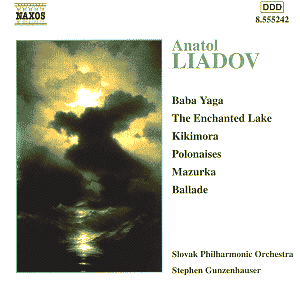 Composer: Anatol Liadov
Composer: Anatol Liadov
Works: Baba-Yaga (op. 56), Intermezzo (op. 8), Ballade (op. 21b), The Enchanted Lake (op. 62), Mazurka (op. 19), Nenie (op. 67), Polonaise (op. 49), Polonaise (op. 55), Kikimora (op. 63), Fragment from the Apocalypse (op. 66)
Performers: Slovak Philharmonic Orchestra, Stephen Gunzenhauser (conductor)
Recording: Concert Hall of Slovak PO, May 1985; Reissued from Marco Polo 8.220348
Label: NAXOS
Anatol Liadov, a composer often overshadowed by his contemporaries, emerges in this recording as a figure both intriguing and frustrating. His orchestral works, characterized by vivid orchestration and an enchanting command of color, reflect a unique Russian sensibility that embodies both folklore and the mystical. This collection offers a tantalizing glimpse into Liadov’s aural landscape, showcasing pieces that range from the delightful to the grotesque, each imbued with the kind of meticulous craftsmanship that marks his style.
Stephen Gunzenhauser leads the Slovak Philharmonic Orchestra with a sure hand, bringing to life the intricate textures of Liadov’s scores. The Mazurka opens with a buoyant piccolo solo that sets the stage for a lively romp, executed with both precision and charm. This piece, while seemingly straightforward, is given a buoyancy that invites repeated listening, revealing layers of rhythmic nuance that are often overlooked in less attentive performances. The two Polonaises, while sharing thematic material, do not quite reach the heights of their more illustrious counterparts in Rimsky-Korsakov’s oeuvre; however, Gunzenhauser’s approach infuses them with a sprightly vigor that keeps the listener engaged.
The more substantial works, namely Baba-Yaga and Kikimora, display Liadov’s affinity for the grotesque. The eerie opening of Kikimora, with its chilling saxophone and tremolo strings, conjures an atmosphere of delightful malevolence. Gunzenhauser captures the unsettling spirit of the piece, allowing the orchestration to breathe while maintaining clarity in the ensemble sound. The contrasts between the sinister undertones and the whimsical elements are deftly navigated, effectively evoking the tales from which these compositions spring.
Liadov’s ability to evoke a sense of melancholy is most poignantly realized in Nenie, where the longing inherent in the melodic lines is enhanced by the transparency of the orchestration. The Slovak Philharmonic’s commitment to clarity serves this work well, allowing every line to resonate with emotional weight. It is here that the recording’s engineering merits special mention; the balance achieved between the instrumental forces allows for a vivid representation of Liadov’s sound world, enabling the listener to appreciate the subtleties of his orchestral palette.
The sound quality of this Naxos release is commendable, capturing the essential clarity of Liadov’s textures without obscuring the richness of the orchestration. The decision to maintain a “dry” acoustic in the foreground, with a subtle ambient bloom in the background, enhances the listener’s experience, highlighting the intricate interplay of the orchestral voices. This sonic approach aligns well with Liadov’s style, which thrives on transparency and clarity rather than overwhelming lushness.
Comparisons with other recordings of Liadov’s work reveal that while the Slovak Philharmonic may not rival the most prominent orchestras, their performance here is robust and spirited. The vividness of the interpretations stands out, particularly when set against the more restrained or over-embellished renditions found in other recordings. For instance, the playful intricacies of the Intermezzo shine under Gunzenhauser’s baton, elevating it beyond mere youthful exuberance into a realm of artful sophistication.
Liadov’s legacy, marked by what might have been, resonates deeply throughout this recording. His gift for crafting enchanting soundscapes is palpable, and the listener is left to ponder the breadth of his potential had he fully realized it. The Slovak Philharmonic Orchestra, under the guidance of Stephen Gunzenhauser, delivers a performance that is both respectful of Liadov’s intention and vibrant in execution. This collection not only celebrates the beauty of his existing works but also serves as a poignant reminder of the creative depth that remains tantalizingly just out of reach.



